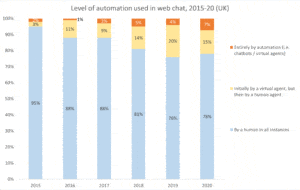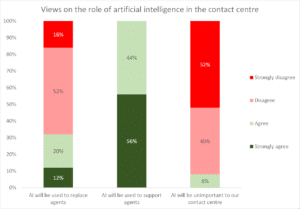AI in the Contact Centre: replacing or augmenting agents?
As AI can be given access to all of the relevant data a company holds on its customers, as well as unstructured data held elsewhere (for example, forums or social media channels), it has a far wider source of knowledge from which to draw compared to human agents.
In theory, an AI with sufficient sophistication could make human agents all but unnecessary, but for the foreseeable future, AI will usually work alongside its human colleagues.
This article is taken from recent ContactBabel research titled “The Inner Circle Guide to AI, Chatbots and Machine Learning”, which is available free of charge from this site.
Current and Future Use of AI in the Contact Centre
Despite a low current use of AI across industries, there is widespread interest in implementing this solution, with 35% of UK survey respondents intending to implement AI within 12 months. While these figures are probably overly ambitious, it does show real interest in AI coming from the contact centre industry.

Use Cases for AI in the Contact Centre
There are numerous use cases for AI in contact centres, and these are growing all of the time. In order to structure “The Inner Circle Guide to AI, Chatbots and Machine Learning”, we chose four wide areas in which AI is actually helping customer contact now:
- Self-Service
- Assisted Service
- Interaction Analytics
- Robotic Process Automation and AI.
There can often be overlap between these areas, for example when a self-service interaction is passed to an agent, who then hands off to robotic process automation.
It is important that the various elements comprising AI should not be viewed in isolation. When they work together, the benefits can be much stronger and unlike siloed applications, AI’s capabilities can be made available to any channel, whether live or automated.
It should also be noted that some of these use cases can also apply to non-contact centre staff. For example, staff in physical stores can be given access to AI reasoning capabilities in order to answer technical questions, and can even be used for internal staff to answer their questions on products or services.
Example Self-Service Use Cases
Replace or augment IVR which is rigidly structured
Website navigation assistance: help customers around the website and provide answers to FAQs. Feedback from customers can help to measure the success or otherwise of the AI. A path to live assistance should always be offered
Develop and support true omnichannel capabilities: ContactBabel research has consistently shown that siloed systems and processes are the single largest factor holding companies back from being able to offer a true omnichannel experience to their customers. AI encourages the decoupling of data from the channel of engagement as it draws data from many sources in order to recognise patterns and act accordingly, with AI’s capabilities being used on any channel, whether in a self-service environment or through assisting agents
Offer 24/7 self-service assistance
Example Assisted Service Use Cases
Use real-time analytics on calls to improve the quality of interaction, agent behaviours and customer outcomes
Identify cross-selling and upselling opportunities (this can be used in either an assisted or automated environment)
Augment agent capabilities in real time to improve outcomes
Use sentiment analysis in real-time to support outcomes.
Example Interaction Analytics Use Cases
Recognise patterns of customer behaviour: e.g. use sentiment analysis to analyse large blocks of data and show that customers trying to carry out a specific action are more likely to be stressed and annoyed, allowing the business to investigate and reengineer the process
Customer behaviour predictions: look for which customers are defecting, and identify any patterns in their behaviour or experiences. Learn which actions are most successful at keeping them loyal
Predictive routing, inc. CTI-like information popping to allow better matches and outcomes
Monitor, quantify and improve agent performance through post-call analytics
Predict the actions and requirements of the customer, improving cross-selling / upselling opportunities
Discover areas for improvement and automation in association with RPA
Use customer journey analytics to identify bottlenecks and processes which frustrate customers and create unnecessary callbacks
Improve identity verification and customer authentication and decrease fraud
Improve workforce optimisation and training
Quality assure 100% of calls and predict QA and CX metrics (e.g. NPS)
Share intelligent real-time alerts with agents
Predicted CX and QA metrics
Robotic Process Automation Use Cases
Use RPA/AI to populate fields and take some tasks away from agents within the call
Use RPA/AI for post-call wrap-up and to kick off and monitor back-office processes.
Chatbots
Perhaps the most popular current use of AI in the customer contact environment is in handling digital enquiries, where web chats generally take far longer than phone calls (due to agent multitasking, and typing time) and some email response rates can still be measured in days.
Whereas only 5% of web chats had any automation involved in 2015, this had grown to 24% in 2019, mainly as a result of initial handling by automated chatbots which may then hand off to live agents where appropriate.

It’s important to note that not all chatbots or virtual agents are powered through AI and machine learning, as many use programmer-defined rules and scripting in order to retrieve answers from a knowledge base. These types of chatbot can still have great value to businesses, especially where there are a relatively small number of questions being asked by customers, and they can be very cost-effective too.
Views on AI in the Contact Centre
AI is often seen by the general public and media as being used to oust humans from their employment. Our survey respondents generally do not believe that AI will replace agents: although 32% agreed to some extent that this would be the case, 68% disagreed. Respondents from large 200+ seat contact centres were more likely to feel that AI would replace human agents, with those in small and medium operations doubting that this would be the case. However, it is worth noting that the belief that AI will replace agents has strengthened over the past few years.

Unanimity was found when the question was asked as to whether AI would support human agents, with all respondents agreeing or strongly agreeing that this would be the case, reducing risk, speeding up responses and providing customers with higher quality resolutions.
52% strongly disagreed that AI would be irrelevant to their contact centre, with general agreement that AI will affect contact centres of all sizes. This figure is growing year on year as AI becomes more widespread and the benefits better understood.
The Future of AI in the Contact Centre
In the longer-term, there’s no doubt that AI will be used as a key part of handling customer interactions in most businesses, but the question is: how? The use of AI should be focused on use cases where the AI does a better job than a human, whether that’s being quicker, more accurate, available 24/7 or able to see patterns in data that no person could see.
It’s our view that people call people not necessarily because they want to hear a friendly voice, or that they’re Luddites who won’t countenance automation, but because they’ve found through experience that this is the most effective way of making sure their issue is resolved.
So while AI-enabled automation will handle much of the simple work, customers will still seek out a live channel for complex or emotional interactions: probably voice, but perhaps digital or video too, as customer confidence in these channels builds up.
Yet even here, AI will be playing a part, identifying the customer’s intent, gauging their sentiment, and understanding through past experience what the appropriate actions for the agent will be. Over a long period of time, AI will become thoroughly enmeshed in every element of customer interactions: the rise of the robots will be slow, but inexorable.
Find out more:
To learn more about the use of AI in UK and US contact centres, please download:
The Inner Circle Guide to AI, Chatbots and Machine Learning (2nd edition) – UK and US versions
The Inner Circle Guide to AI-Enabled Self-Service – UK and US versions

